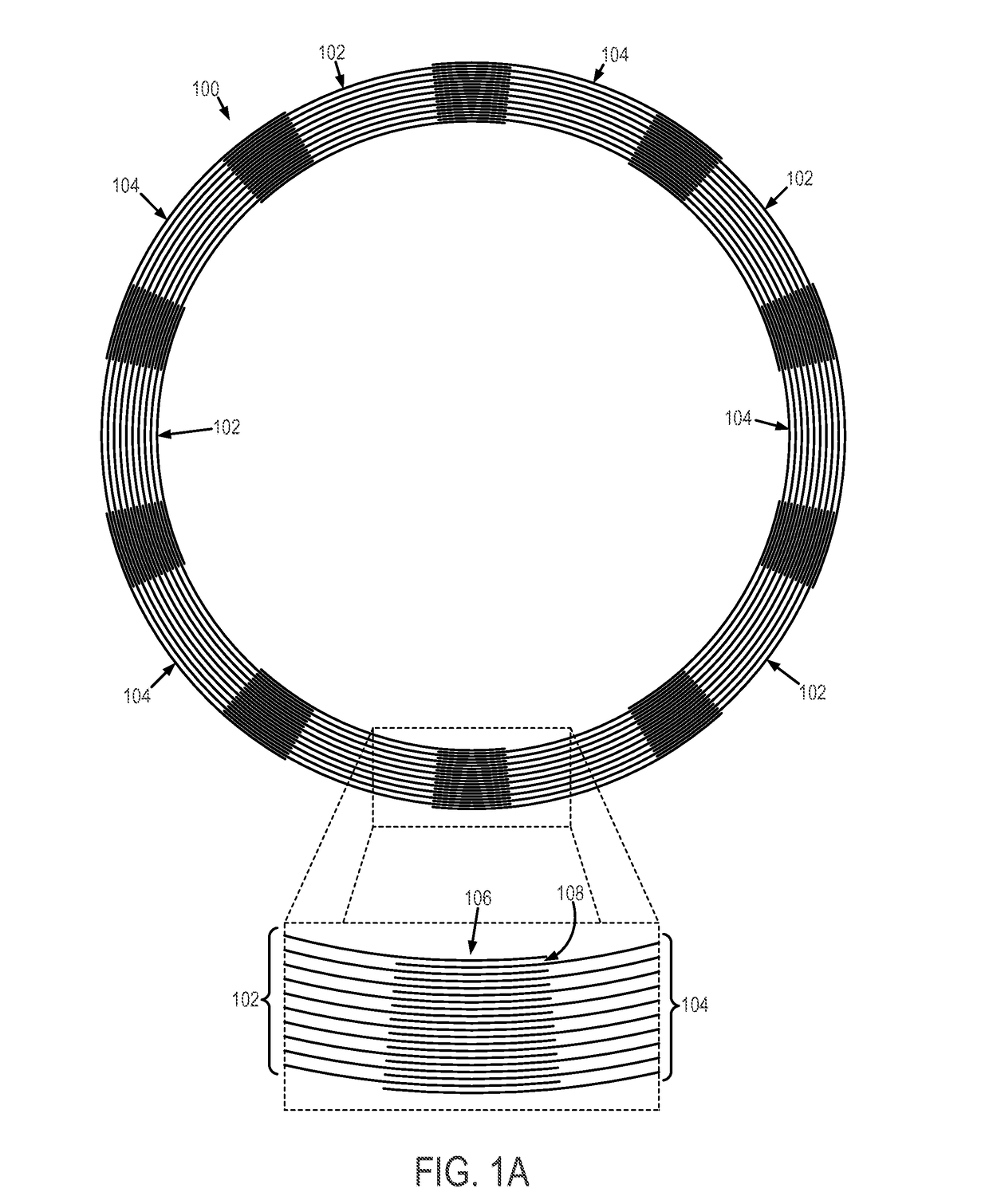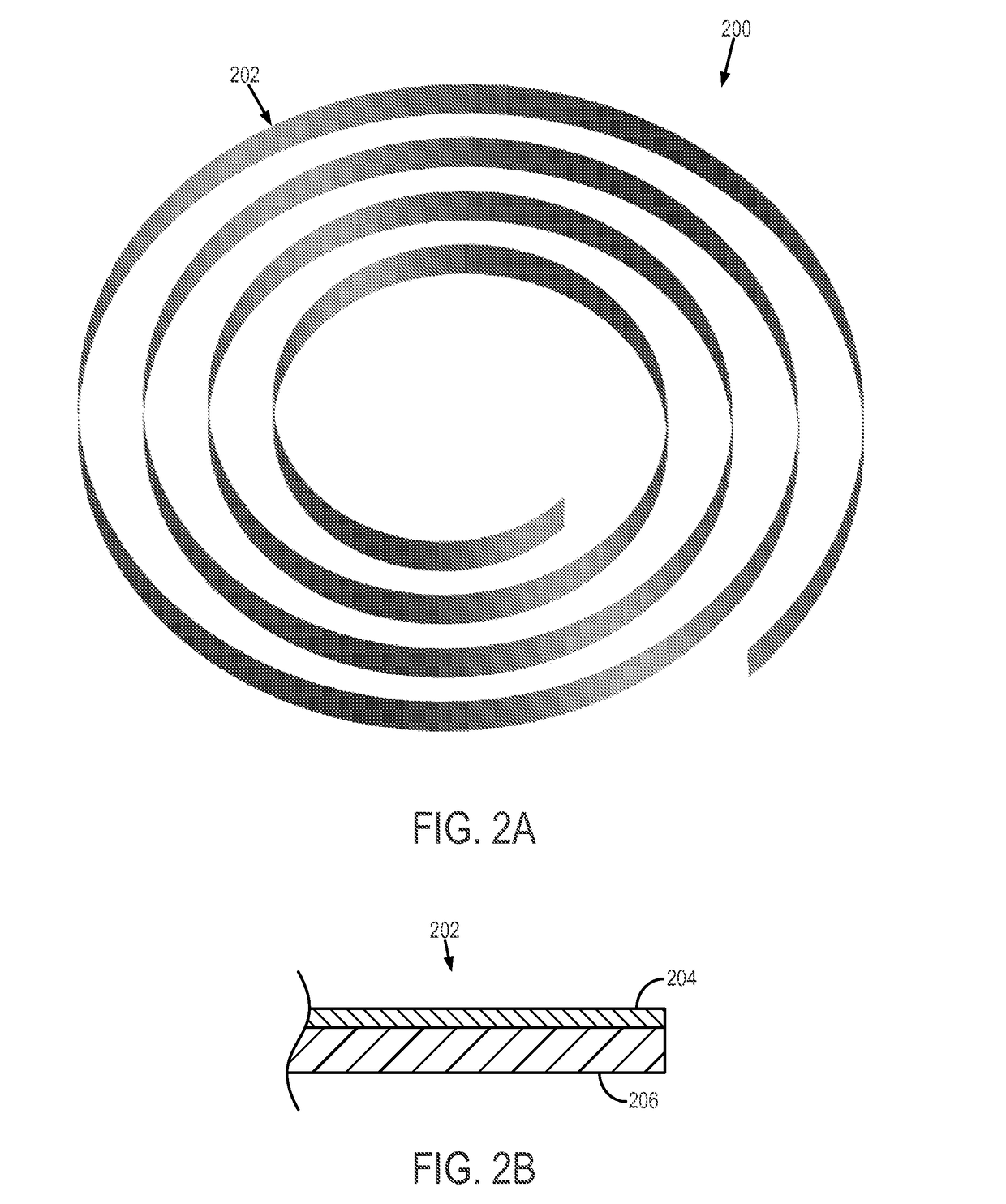High q-factor magnetic resonance imaging radio frequency coil device and methods
a radio frequency coil and q-factor technology, applied in the field of radio frequency coils, can solve the problems of affecting the performance of the surface coil, causing unwanted heating, and required high rf frequencies, and achieve the effect of reducing the flow of countercurren
- Summary
- Abstract
- Description
- Claims
- Application Information
AI Technical Summary
Benefits of technology
Problems solved by technology
Method used
Image
Examples
example # 1
Example #1: Folded Gap Loop with 10 Sets of Overlapping Conductors
[0106]An example of a meta-metallic structure similar to the one illustrated in FIG. 1A can be constructed to include 10 sets of 10 foil layers that form a loop. Each foil set wraps 51 degrees and overlaps with the next set on each end for 15 degrees. The capacitance of the overlapping regions was designed to resonate with the inductance of the loop at a frequency of 400 MHz. The structure was simulated using the finite element computer program Ansys High Frequency Structure Simulator (HFSS) (Canonsburg, Pa.).
[0107]The current in each layer is directed primarily around the loop. The current is maximum in the non-overlapping regions, decreases in the overlapping regions and goes to zero on the ends of the foils. The current magnitude in a foil layer is substantially proportional to the area of overlap with adjacent foils. For illustration purposes, the foil material was chosen to be stainless steel with a conductivity ...
example # 2
Example #2: Folded Gap Loop with 2 Sets of Overlapping Conductors
[0117]An example of a meta-metallic structure similar to the one illustrated in FIG. 1C can be constructed to include two sets of 10 foil layers. The structure has an inner radius of 5 mm, an outer radius of 10.8 mm, a spacing between adjacent foil layers of 0.30 mm and an overlap distance of 1.2 mm. By constructing the overlapping foil region with a constant distance instead of angle, the capacitance is constant, which produces more uniform currents across the conductor layers.
[0118]A conducting boundary was placed at a radius of 28 mm. The structure resonates at 393 MHz and, for a foil thickness of 1.6 μm, has a Q-value of 5,514. This can be compared to a Q-value of 1,407 for an LGR of the same inner and outer radius and the same metal. The resulting Q-enhancement ratio is 3.9. The eddy current dissipation lowers the Q-enhancement, as expected. The inductance of this folded-gap loop is approximately 2.5 times higher ...
example # 3
Example #3: Self-Resonant Spiral
[0119]An example of a meta-metallic structure similar to the one illustrated in FIG. 2A can be constructed to include a single spiral coil with an inner radius of 3 mm, an outer radius of 8 mm, 4 turns, and a foil thickness of 2.2 μm. A conducting boundary was placed at a radius of 20 mm. The resonance frequency of this structure is 407 MHz with a Q-value of 2,169. This compares to a Q-value of 809 for an LGR of the same inner and outer radius.
[0120]Eddy current dissipation is expected to lower the Q-enhancement; however, the example spiral coil has approximately 1.8 times the inductance of the LGR and this factor raises the Q-enhancement ratio. The nearly sinusoidal (nonuniform) current distribution with foil length in the spiral does not have much effect in lowering the Q-enhancement. For the different structure types that have been simulated, it was found that close attention to balancing the currents by equal capacitance does not significantly imp...
PUM
 Login to View More
Login to View More Abstract
Description
Claims
Application Information
 Login to View More
Login to View More - R&D
- Intellectual Property
- Life Sciences
- Materials
- Tech Scout
- Unparalleled Data Quality
- Higher Quality Content
- 60% Fewer Hallucinations
Browse by: Latest US Patents, China's latest patents, Technical Efficacy Thesaurus, Application Domain, Technology Topic, Popular Technical Reports.
© 2025 PatSnap. All rights reserved.Legal|Privacy policy|Modern Slavery Act Transparency Statement|Sitemap|About US| Contact US: help@patsnap.com



